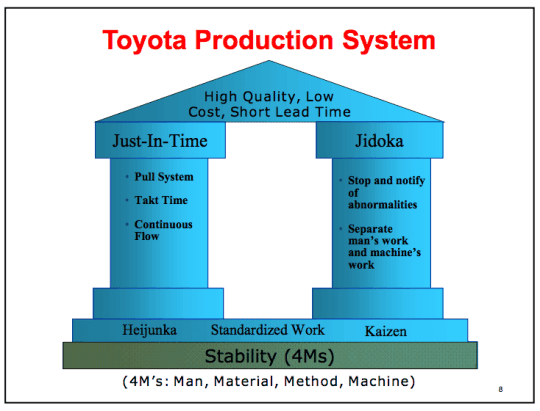 Last week at the Lean Healthcare Transformation Summit, I really enjoyed the presentation by Jamie Bonini, General Manager of the Toyota Production System Support Center (TSSC). Jamie started his career at Chrysler (where he knew Jamie Flinchbaugh, a good friend of this blog) and both Jamies, like me, are graduates of the MIT Leaders for Global Operations program.
Last week at the Lean Healthcare Transformation Summit, I really enjoyed the presentation by Jamie Bonini, General Manager of the Toyota Production System Support Center (TSSC). Jamie started his career at Chrysler (where he knew Jamie Flinchbaugh, a good friend of this blog) and both Jamies, like me, are graduates of the MIT Leaders for Global Operations program.
Jamie shared great insights on what we might call “Lean culture” as Toyota aims for and others have emulated.
Jamie described Toyota's organization culture as an integrated system, consisting of:
Basic philosophy
- Customer first (patient first in healthcare)
- People are the most valuable resource
- Kaizen (continuous improvement)
- Focus on the workplace (shopfloor focus, gemba)
Technical tools
These are the methods like kanban, just in time production, etc. As Jim Womack said in his keynote, these tools are “necessary, but not sufficient” because they have to be combined with the philosophy and managerial practices. The classic “TPS house” illustration covers these practices (or see Jamie's diagram, below):
Managerial approach
Jamie said the key managerial role is to develop people to surface problems and to solve problems (to better serve the customer). He emphasized this many times. Managers and leaders are responsible for helping create a culture where people can surface and solve problems.
The ideal is to be notified of any abnormality immediately and to solve problems as they occur (while the situation is still fresh).
Jamie referenced back to Dr. John Toussaint's keynote, with all of the things that went wrong during his mother-in-law's healthcare, saying, “A problem solver would have arrived immediately to solve the root cause and prevent it from happening again.”
Unfortunately, that's still not the culture in healthcare, generally.
That's the power of Lean principles… it's not about copying tools, it's about adopting the culture and philosophy… that's what makes the tools useful, when oriented in the direction of the customer. For example, I'm not sure how saying “no sweaters on the back of your chair” (in the Kyocera “Lean office” initiative) helps the customer at all! That's why I called that “L.A.M.E.” and not Lean. That's why we need to be customer driven (solving problems that matter) rather than being tools driven.
Four roles of a leader
Jamie talked about the four roles that each leader must play in a Lean transformation:
- Show passionate commitment for improvement and TPS
- Learn TPS principles, well enough to teach them to others (the basic principles and the details)
- Build an organizational culture that surfaces and solves problems
- Be active in the gemba (go and see… “genchi gembutsu”)
What do you think? Please scroll down (or click) to post a comment. Or please share the post with your thoughts on LinkedIn – and follow me or connect with me there.
Did you like this post? Make sure you don't miss a post or podcast — Subscribe to get notified about posts via email daily or weekly.
Check out my latest book, The Mistakes That Make Us: Cultivating a Culture of Learning and Innovation:










Engaging with Jamie is always a learning experience. I hope everyone at the conference appreciated the experience. Last time we chatted at an airport (both coming off long flights and probably looking and certainly feeling ragged) we got into a deep conversation about how to fix the university system in the US.
Fixing the university system… you might be interested in Bob Emiliani’s new book and blog on this (“The Lean Professor”). He’s also written another book about Lean in the college / university setting.
http://www.bobemiliani.com/the-lean-professor/
Great post. I am looking back 5 or 6 years and as much as this rings true now I am not sure it would have resonated then. I guess the good news is we are figuring this out and there are bona fide examples in healthcare that can inspire us. Maybe the bad news is it is still very hard and I am not sure there are that many leaders that are capable of moving their organizations down the right path.